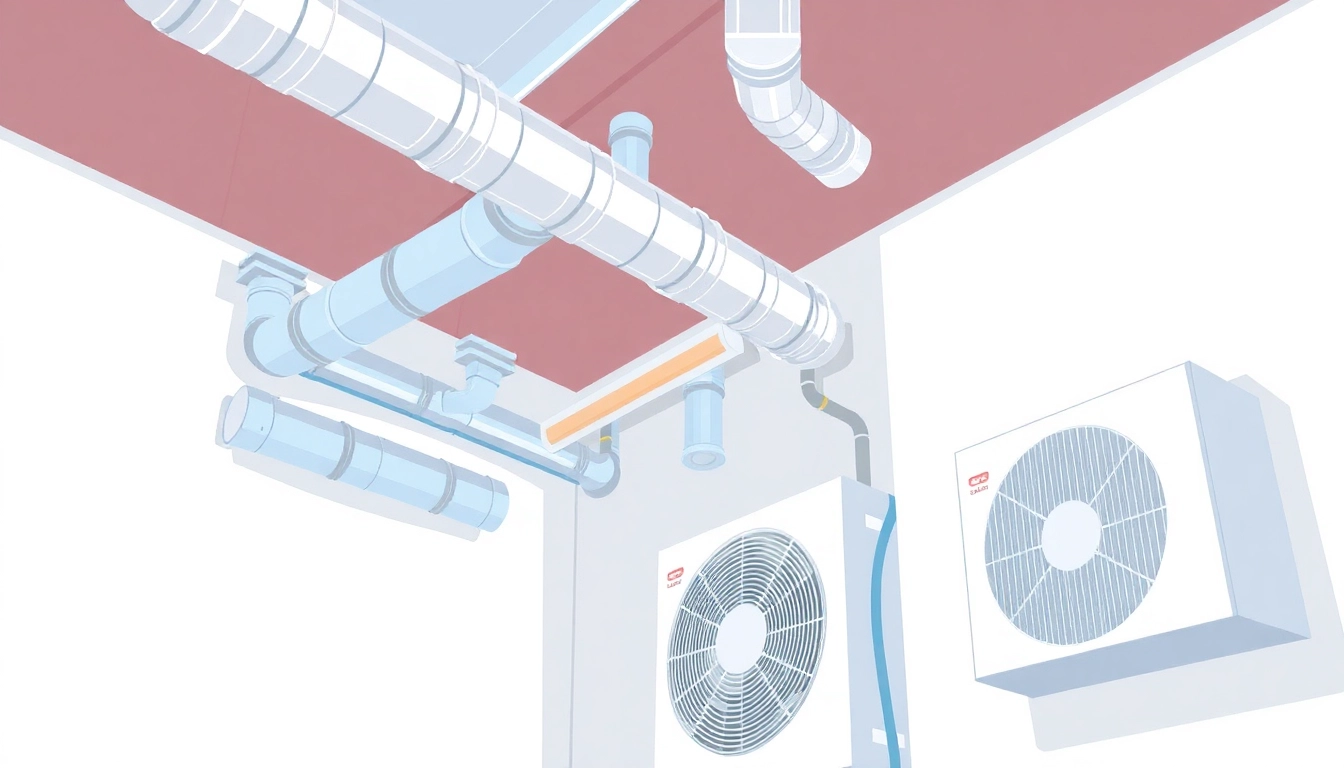1. Introduction to Central Air Conditioning
In modern homes, maintaining a comfortable indoor climate is crucial, especially during the sweltering summer months. This is where central air conditioning systems come into play, providing a seamless solution for temperature control across various rooms in a house. But what exactly is a central air conditioner? It’s essential to understand this system, its components, benefits, and how it works to appreciate its significance in indoor climate management. A central air conditioner circulates cool air through a system of supply and return ducts, effectively delivering conditioned air to every corner of your home. If you’re looking for a detailed exploration of what is a central air conditioner, you’ve come to the right place.
1.1 What is a Central Air Conditioner?
A central air conditioner is a system designed to cool your entire home efficiently. Unlike window units or portable air conditioning systems, which serve a single room, central AC systems maintain comfortable temperatures throughout the home’s multiple spaces by utilizing a network of ductwork. This process helps maintain a consistent temperature, humidity control, and improved indoor air quality. Through the circulation of cool air generated in a central location, these systems effectively cool down entire homes, which is particularly valuable in larger living spaces or climates with extreme weather conditions.
1.2 Key Components of Central Air Conditioners
Central air conditioning systems consist of several critical components that work in tandem to provide cooling. Understanding these parts can help homeowners make informed decisions regarding their air conditioning needs:
- Thermostat: The device that regulates the temperature within your home, allowing you to set your desired comfort levels.
- Evaporator Coil: Located indoors, this coil absorbs heat from the indoor air and cools it using refrigerant gases.
- Compressor: Situated outside the home, the compressor pumps refrigerant through the system, transforming it between liquid and gas states to facilitate heat exchange.
- Condenser Coil: This outdoor coil dissipates heat absorbed by refrigerant, allowing it to return to its liquid state before re-entering the evaporator coil.
- Ductwork: The network of ducts that distribute cooled air throughout the home and return warm air back to the unit for re-cooling.
- Air Handler: Part of the indoor system that circulates air through the ductwork.
1.3 Benefits of Central Air Conditioning Systems
Installing a central air conditioning system offers several advantages for homeowners:
- Uniform Cooling: Unlike window units, central air conditioners provide consistent temperature regulation throughout all areas of the home, eliminating hot and cold spots.
- Energy Efficiency: Central air conditioning systems often have higher SEER (Seasonal Energy Efficiency Ratio) ratings than room units, leading to lower energy costs.
- Improved Indoor Air Quality: These systems can be equipped with advanced air filtration systems that help remove dust, allergens, and other contaminants, enhancing overall air quality.
- Convenience: Central systems can be operated remotely, often featuring programmable settings that allow for tailored temperature control based on daily schedules.
- Enhanced Home Value: A well-installed and maintained central air conditioning system can significantly boost the value of a property, making it more appealing to potential buyers.
2. How Central Air Conditioners Work
2.1 The Cooling Process Explained
The cooling process of a central air conditioning system involves a cycle of heat absorption and heat expulsion. The process begins when the thermostat detects that the indoor temperature exceeds the set level. The air conditioning unit activates, and the following steps occur:
- The indoor air handler draws warm air in through return ducts.
- The warm air passes over the evaporator coil, where refrigerant absorbs the heat, cooling the air.
- The cooled air is then distributed through supply ducts into various rooms.
- The refrigerant, now warmed up, is sent to the compressor, where it is pressurized.
- The pressurized gas moves to the outdoor condenser coil, dissipating heat into the outdoor air, thus returning the refrigerant to a liquid state.
- The cooled liquid refrigerant is sent back to the evaporator coil, and the cycle repeats.
2.2 Role of Ductwork and Ventilation
The ductwork in a central air conditioning system plays a pivotal role in its effectiveness. Properly designed and insulated ducts ensure that air operates efficiently and minimizes leakage. Here’s how ductwork functions:
- Supply Ducts: Responsible for delivering cooled air from the air conditioning unit to the various rooms throughout the home.
- Return Ducts: Collect warm air from the rooms and carry it back to the air handler for re-cooling.
- Vents and Registers: Openings located in walls, floors, or ceilings, these allow air to flow into rooms, and also facilitate the return of warm air.
2.3 Comparing Central AC to Other Systems
When evaluating air conditioning options, it’s essential to consider how central AC systems compare to other solutions, such as window units, ductless mini-splits, and portable air conditioners:
- Window Units: Typically used for cooling small spaces, these units are less efficient for larger homes and can obstruct views when installed in windows.
- Ductless Mini-Split Systems: Offer flexibility with zoned cooling for individual rooms but often come with a higher installation cost compared to central AC.
- Portable Air Conditioners: Easy to move between spaces, these are generally less efficient and may not adequately cool large areas.
3. Energy Efficiency and Central Air Conditioners
3.1 SEER Ratings Explained
The efficiency of air conditioning systems is often measured using the Seasonal Energy Efficiency Ratio (SEER). A higher SEER rating indicates better energy efficiency, which translates into lower operational costs. Most central AC units available on the market have a SEER rating ranging from 14 to 20, with advancements in technology leading to even higher ratings. For homeowners, selecting a system with a SEER rating of 16 or above can significantly reduce annual energy bills and improve comfort levels.
3.2 Tips for Maximizing Efficiency
To optimize the performance and efficiency of your central air conditioning system, consider the following tips:
- Regular Maintenance: Schedule annual professional maintenance to ensure your system is running at peak efficiency.
- Utilize Landscaping: Plant shade trees or install awnings to reduce the amount of heat your home absorbs, thereby easing the workload on your AC system.
- Seal Ductwork: Inspect ductwork for leaks and ensure all joints are sealed to prevent conditioned air from escaping.
- Upgrade Filters: Use high-efficiency filters and replace them regularly to improve airflow and indoor air quality.
- Set a Programmable Thermostat: Adjust your thermostat settings based on daily routines to avoid unnecessary energy expenditure.
3.3 Understanding Operating Costs
Knowing the costs associated with operating a central air conditioning system is crucial for budget management. Variables that affect operating costs include:
- Energy Costs: Fluctuating energy prices can significantly impact your monthly bills.
- System Efficiency: Higher SEER-rated systems, while initially more expensive, lead to long-term savings.
- Usage: The duration and intensity of operation, alongside outdoor temperatures, dictate energy consumption.
4. Installation and Maintenance of Central AC Systems
4.1 Factors to Consider During Installation
Installing a central air conditioning system requires careful planning to ensure optimal performance:
- System Sizing: Correctly sizing the system based on the home’s square footage, insulation levels, and layout is critical to avoid inefficiencies.
- Ductwork Assessment: Existing ducts must be inspected for leaks and capacity to handle the new system’s airflow requirements.
- Location: The placement of the outdoor unit should consider landscaping, access for maintenance, and noise considerations for adjacent properties.
- Local Regulations: Ensure compliance with local building codes and regulations regarding installation and maintenance.
4.2 Routine Maintenance Tips
Regular maintenance can extend the life of your system, improve efficiency, and reduce energy costs. Here are essential maintenance practices:
- Monthly Filter Checks: Make it a habit to check and replace or clean your air filters every month or as required.
- Regular Professional Inspections: Schedule annual check-ups with certified HVAC technicians to address potential issues before they escalate.
- Clean the Outdoor Unit: Keep the area around the outdoor unit clear of debris, leaves, and any growth that may restrict airflow.
- Check Refrigerant Levels: Ensure the system has the appropriate refrigerant level, as low refrigerant can indicate leaks or inefficiencies.
4.3 Common Issues and Troubleshooting
Central air conditioning systems can face various issues over time. Knowing how to identify these problems can save homeowners both time and money:
- Inadequate Cooling: If some rooms are not cooling adequately, the ductwork may need inspection for leaks or blockages, or the system may be undersized.
- Strange Noises: Unusual sounds, such as rattling or buzzing, may indicate loose parts or issues within the motor and could warrant immediate inspection.
- Frequent Cycling: If the system turns on and off frequently, it might be due to a dirty filter, oversized unit, or thermostat problems.
- High Energy Bills: If energy costs surge unexpectedly, this could point to inefficiencies in the system, leaks, or outdated equipment.
5. Frequently Asked Questions About Central Air Conditioning
5.1 What is the difference between AC and central AC?
Traditionally, “AC” refers to any air conditioning unit, while “central AC” specifically indicates a whole-home system that cools multiple rooms through ductwork. Central AC is typically more efficient for larger homes, whereas standalone AC units are more suitable for individual rooms.
5.2 How to determine if you have central AC?
Look for air registers or vents in each room. If your home has a central air conditioning system, it will have ducts that transport air from a central unit throughout your living space.
5.3 What to expect from a central AC installation?
During installation, expect HVAC professionals to evaluate your home for suitable system size, assess ductwork, and choose the best location for both the indoor and outdoor units. The installation process typically takes several hours to a day and involves both mechanical and electrical work.


